
From: “Glimpses of Halifax and surroundings along the lines of the Dominion Atlantic and Central Railways: Beautifully illustrated with views of Halifax, Dartmouth, Weymouth, Digby and the Annapolis Valley”, 1900
Amicitia Crescimus

From: “Glimpses of Halifax and surroundings along the lines of the Dominion Atlantic and Central Railways: Beautifully illustrated with views of Halifax, Dartmouth, Weymouth, Digby and the Annapolis Valley”, 1900

From The Story of Dartmouth, by John P. Martin:
“This first picture was taken at the intersection of Prince Albert Road and Ochterloney Street on Saturday, September 14, 1907 (Below, as it looks in more modern times). The length of the shadow of the telephone pole indicates that the morning is not far advanced, yet there is almost a complete absence of pedestrian or vehicular traffic because by this time of day the market wagons and ice-carts have passed along to the ferry. An occasional delivery team from a downtown store might go by, otherwise, the quietude remained unbroken until noon hour when workmen came out of the Skate Factory for dinner.
The picket fence (hard to see, poor photo quality) at the left enclosed the vacant field of B. H. Eaton (later, Eaton Ave). The fenced-off level due north of the Starr Factory (middle ground) was the route of Bridge Street.
Within the last century, local truckmen and teamsters backed down to the pool at the right to fill water-puncheons or wash their carriages in fine weather.”
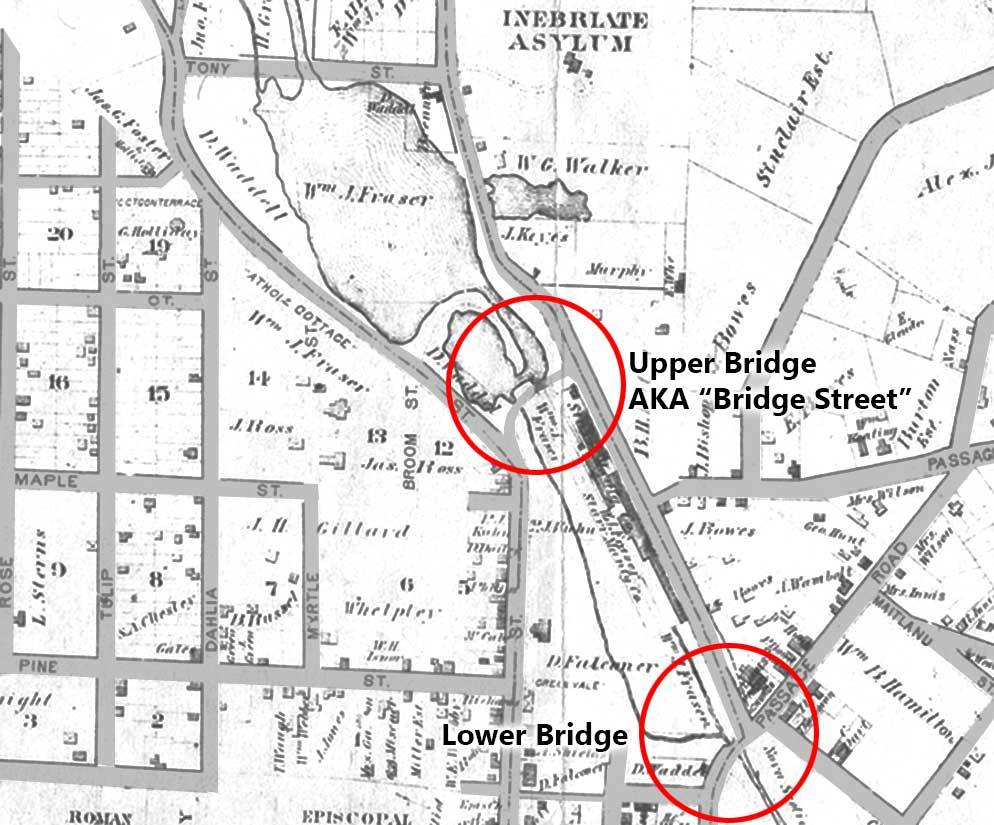
“Traffic to and from downtown Dartmouth crossed a small bridge in the stream opposite the present Memorial Park/ and another bridge at the head of the Starr Works where the road turned northerly to Prince Albert Road. All this was called Bridge Street.
The upper Canal bridge was built in 1886 and Ochterloney Street restored to its present shape. The route used for the previous 25 years over Bridge Street (because of the canal) was then abandoned.”

Just in case anyone tries to tell you differently, John Connor, Dartmouthian, was the first ferry captain.
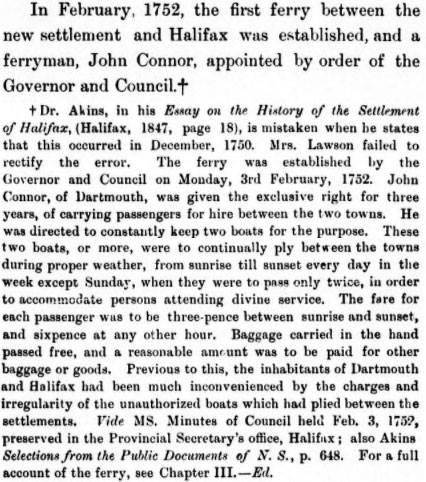
Remember that time Dartmouthians got so fed up with the substandard ferry service, they charted their own course, and organized a committee to start their own ferry service?
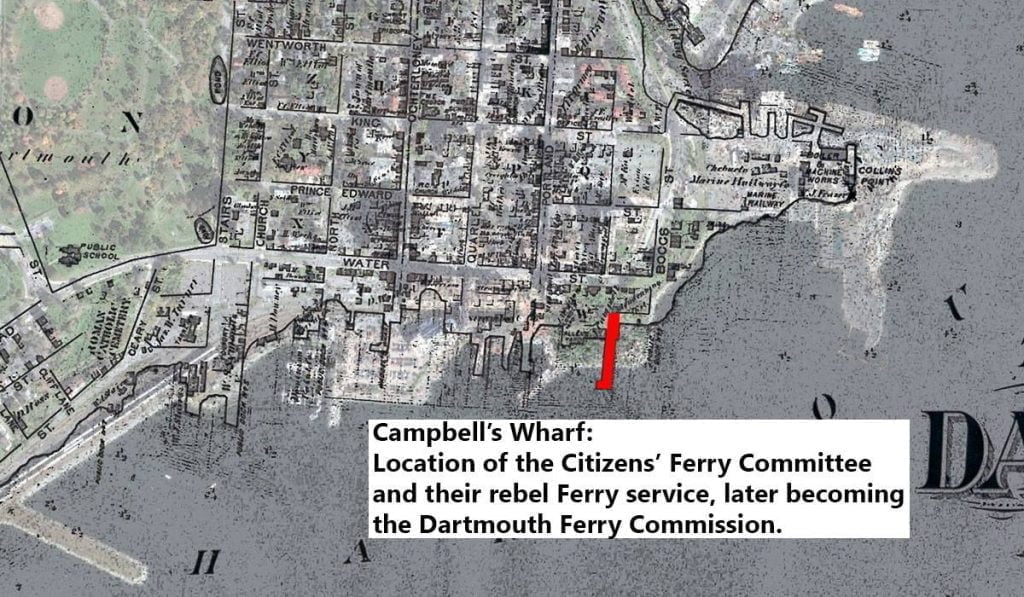
A ferry service that became so popular, the previous operators were abandoned in favor of the people’s service? This group even organized a ferry boat buying expedition to New York, in order to purchase a boat “formerly on the Pennsylvania Annex running from Brooklyn to Jersey City”.
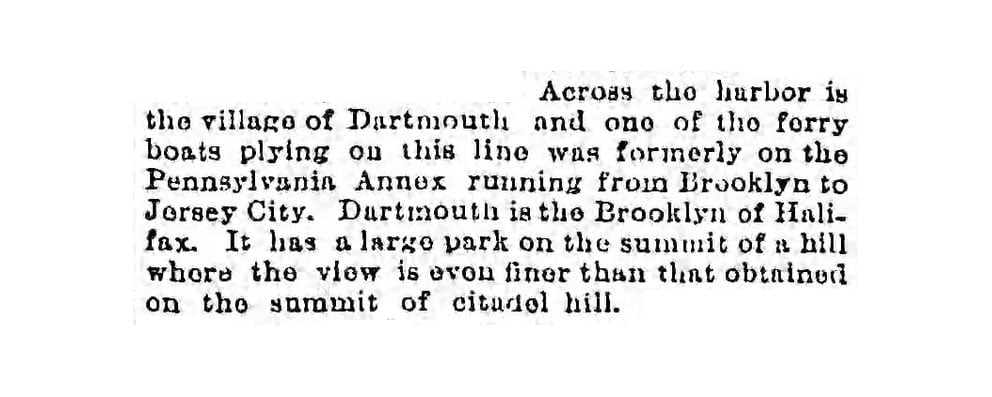
From The Story of Dartmouth, by John P. Martin:
“The struggle between the citizens and the Steamboat Company lasted about three months. In April 1890, legislation was obtained to organize the Dartmouth Ferry Commission. This body took over the liabilities of the Citizens’ Ferry Committee. Delegates were next sent to the United States to negotiate for the purchase of a secondhand ferryboat named the “Annex”. Meantime the small steamer “Arcadia” kept running in opposition to the Company, transporting people for two cents, and later for one cent. Nearly everyone boycotted the regular ferry. By midsummer the Steamboat Company felt obliged to capitulate. Then all the property of the 75-year-old Halifax and Dartmouth Steam Ferry Company was acquired by the new Dartmouth Ferry Commission. The makeshift landing and ticket booth at Campbell’s wharf were abandoned.”
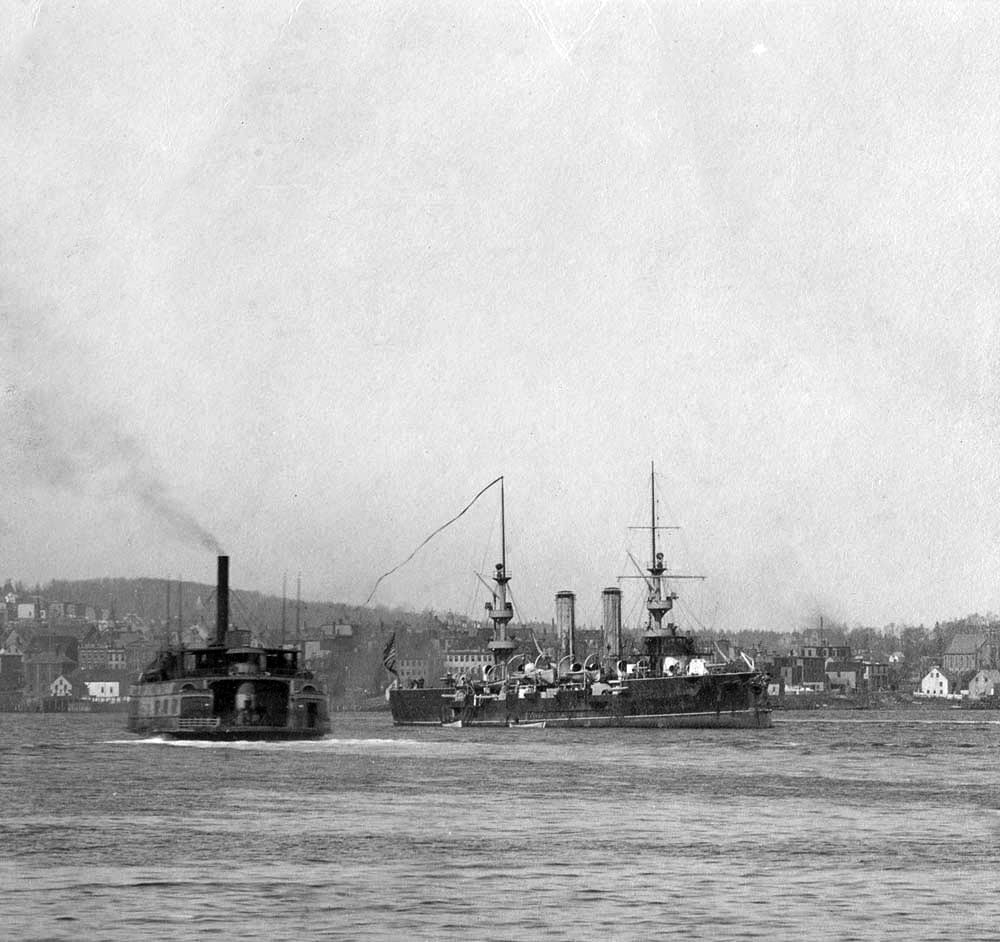
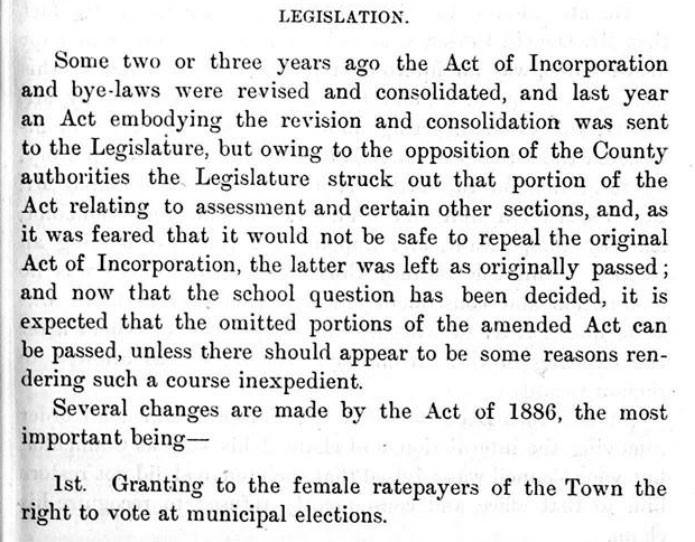
From The Story of Dartmouth, by John P. Martin:
“The first move towards procuring women’s suffrage in Nova Scotia was taken by the Town of Dartmouth in 1886 when they got an Act through the Provincial Legislature extending to female ratepayers the right to vote at municipal elections.
It was effective the following year. Our 1873 Act of Incorporation stated that the privilege of voting was granted to “every male ratepayer.” In other words, widows, and spinsters owning property within the Town had no voice in the election of the Town Council. Evidently, it was then an unheard of thing for women to be associated with polling booths.
In thus extending the franchise to females, Dartmouth led all other Nova Scotia towns and even the capital City of Halifax.”
Dartmouth Annual Report, 1886: http://legacycontent.halifax.ca/archives/DartAnnReps/documents/101-1m-1886.pdf
“Photograph shows the congregation of Dartmouth Lake Church (now Victoria Road United Baptist Church).
The church, also known in its early days as the African meeting house, was founded in 1844. Until 1906 the church was located at the corner of what is now Crichton Ave. and Micmac Blvd.”
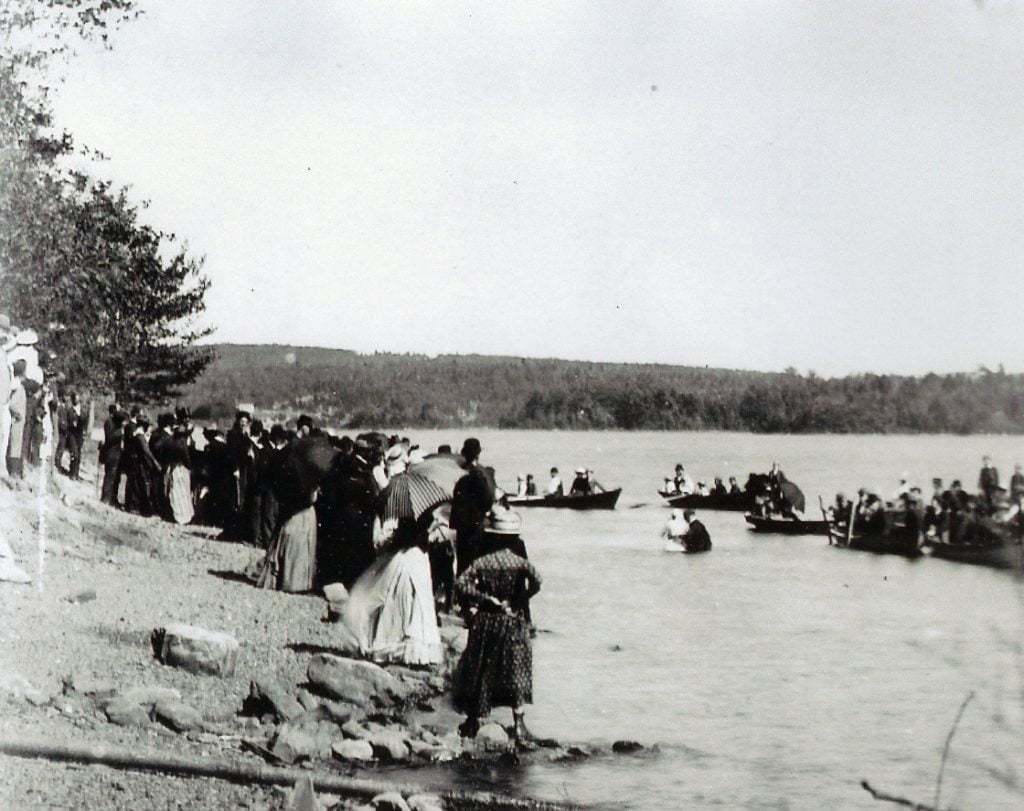
Looks to be located near Birch Cove today. (https://goo.gl/maps/dRmdoHL5mbhbWX7Z9) https://archives.novascotia.ca/Africanns/archives/?ID=149
Plaque from inside Victoria Road Baptist Church:
“In loving memory of early Black fathers who settled at Dartmouth Lake Road 1814, (now Crichton Avenue) and whose abandoned graves were exhumed August 1976, and moved to Christ Church Cemetery. Remembered include: Martha Tynes, George Tynes, Elizabeth Tynes, James Riley and Issac Smith. Dedicated December 7, 1977”
See also:
“Youth and seniors from the East Preston community have been working with a Halifax based video company, Pink Dog Productions to produce a video honoring one of East Preston’s local cultural heroes Mr. Sinclair Williams who was the first African Nova Scotian police officer for the (City of Dartmouth).”

From The Story of Dartmouth, by John P. Martin:
The removal of the Nantucket Whaling Company to Dartmouth in 1785, gave the town its first major industry; and also brought about a marked change in the shape of the 1750 town-plot. A local commission of inquiry set up in 1783, ruled that all but two of the Dartmouth proprietors had failed to fulfill conditions of their grants. The Legislature of Nova Scotia voted a considerable sum of money to assist this enterprise, because candles, sperm oil and other products were as essential then, as are gasoline and electricity in our own day.
Most of the houses and lots in the town-plot were then escheated by the Government, and re-allotted to the Nantucketers. This procedure caused much discontent and created disputes over titles for years afterwards.
These Quaker people were industrious. Years ago, old residents used to relate how they could erect a dwelling within a few days. They must have been co-operative. No time was spent in excavating cellars. That they intended to remain permanently, is evident from the spaciousness of their houses and from the fact that they constantly cultivated and improved the soil by grubbing-up tons of our familiar slate-rock to build breast-high stonewalls along the borders of their gardens and orchards.
What is perhaps the last of these walls, still supports the bank at the corner of King and Queen Streets. On that elevation, the Quakers erected Dartmouth’s first house of worship. It was in this building that the Dartmouth Society of Friends made their decision to remove to Wales in 1792. Seth Coleman was clerk.
Houses directly opposite the site of the Meeting House at 63, 65, and 67 King Street, with their very small squared panes of glass over the porches, are typical of Nantucket style. And families still prominent on Nantucket Island, whose ancestors migrated to Dartmouth at the time, include names like Coleman, Coffin, Bunker, Greaves, Swaine, Macey, Ray, Barnard, Leppard and Paddock.
Promoters of the Whaling Company, like Hon. Thomas Cochran of Halifax; and leading Quakers like Samuel Starbuck and Timothy Folger (Foal-jer), got whole blocks of downtown property near Dartmouth Cove. Their idea of reserving Dartmouth Common was to provide grazing-ground for owners of livestock in the town-plot. They builded better than they knew, for the Common has always been the town’s chief recreational centre.
Besides their downtown holdings, Messrs. Folger and Starbuck obtained large tracts in the suburbs. One grant in 1787 comprised 1,156 acres in the present Westphal district. Another of 556 acres bordering Edward Foster’s property, seems to be near the Rope-works. These two men also made application for the swamp land of four acres, which was to be drained and improved for English meadow. Historian George Mullane, writing of this period, calls it the “Folger and Starbuck land grab”.
In the same year that the Quakers left, there occurred the death of Christian Bartling. He was of Danish origin. Despite the fact that he had built a house in the 1750’s, yet his property was escheated for the Nantucket families. Later he obtained Crown grants near Lake Banook. The well-known Walker families of Dartmouth are his descendants.
Another name to note is that of Thomas Hardin (no. 5 Block B). As an illustration of tangled titles and also of the hazardous existence of pioneer Dartmouthians, the following quaint petition of Mrs. James Purcell, dated 1792, is most enlightening:
“To the Hon. Richard Bulkeley,
The humble petition of Mary Purcell, the Grand daughter of Thomas Hardin, most humbly sheweth. That your honor will be pleased to remember that my Grand Father was one of the first settlers in Dartmouth and lived on said place until about 15 years ago. And Bequeathed said Lott of Land to my mother Jean Hardin which served her apprenticeship in Your Honors family and my father Lawrence Sliney likewise, at my Marrying my present husband James Purcell, about four years ago My Mother and Uncle Thomas Hardin Resigned over their Right and Title to us for to subsist our Family- Which is a Lott of Land that was granted by Lord Cornwallis to my Grand Father which he suffered a Vast Deal of Hardship in Clearing and Erecting a House on it. Likewise Lost his Son by the [Mi’kmaq] as he was Obliged to Oppose them by Day and by Night. My husband having registered said Lott pursuant to the Laws of the Province.
But now being informed by a Letter from Mr. Morrice Surveyor General that said Lott is made over by a Grant from his Excellency Governor Par and his Majestys Council to one Cristian Barlet in Dartmouth which has had no Right or Title to said Lott but was to pay to our Family Twenty Shillings Currency a Year. Therefore I Beg and Emplore the favour of your Honour to see me and my poor children Rightified. And will be in duly bound to pray”.
In that same summer of 1792, another menace presented itself. All the munitions for the port were then kept at the Eastern Battery. Several thousand barrels of gunpowder stored in a wooden building near the border of the forest caused considerable alarm, there were frequent fires in the woods. In a petition to the House of Assembly, the inhabitants of Halifax expressed fear for the safety of their town, and asked that the munitions be moved in a more suitable storehouse and in a more remote section.
Hartshorne and Tremaine’s gristmill commenced about this time. The firm purchased the lower mill stream and lands on both sides, where Richard Woodin had his dwelling. They also obtained permission from James Creighton, the proprietor of the upper stream, to lower the bank at the outlet of the lake, and to dam up the river in order to provide a head of water for the millrace.
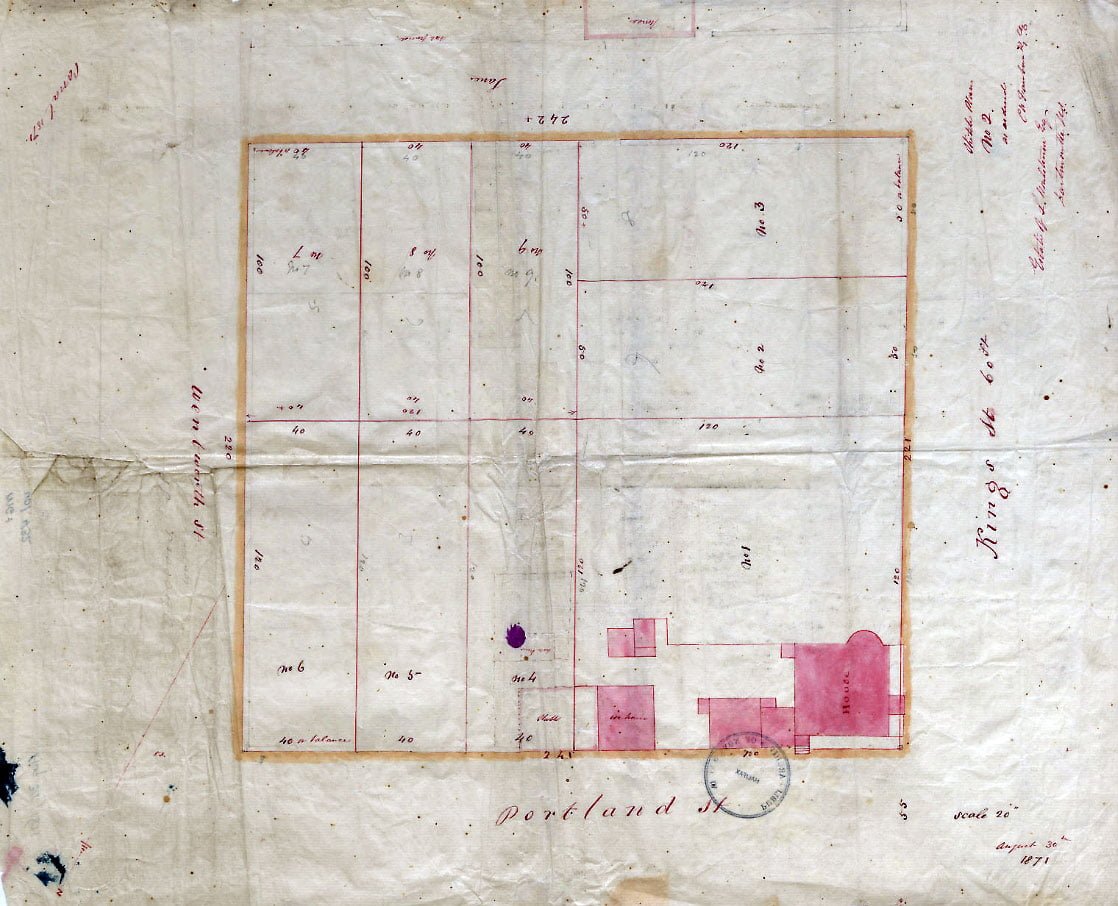
In 1793, Lawrence Hartshorne purchased from Samuel Starbuck, Jr., for £100, the square block “L” bounded by King, Portland, Wentworth and Green Streets. On the old plan it is marked “D”. The lofty tenement building demolished at Woolworth’s corner in 1951, was known a century ago as the “Mansion House” of the Hartshornes. The estate was called “Poplar Hill”.
Jonathan Tremaine acquired the triangular block “M” at Green and King Streets, just below “Poplar Hill”. This had been the property of Samuel Starbuck, senior. But Tremaine’s residence is thought to have been in square block “E”, because he was regranted land at the northeast corner of Portland and Wentworth in 1796, and purchased the remaining lots and buildings in that block from the Starbucks. According to Tremaine genealogy, Jonathan died in 1823 at Dartmouth where he had “a country seat.”
At the same time, the wharves and water-lots left by the Nantucket Whaling Company were also taken over by Hartshorne and Tremaine. For many years this firm had the most extensive flour mill in the Province. Their warehouse was on Water Street in Halifax, whither the finished products were transported by the first vessel built in Dartmouth, “The Maid of the Mill”.
The milling business evidently was profitable in those times, for a third windmill commenced in 1798. An advertisement in the Weekly Chronicle of that year announced that Davis and Barker “have erected a gristmill in Foster’s Cove, and are ready to receive grain to manufacture into flour etc.”
A search through every available record fails to reveal the location of the town-plot ferry-dock during the first four decades of Dartmouth’s history. Certainly the present landing was not the place. The original acclivity of Portland Street can best be gauged by bridging with the eye, the space between the natural heights still seen in the rear of properties on each side of Portland Street, just east of Commercial Street.
The most suitable part of the waterfront for pulling up small boats and erecting cribwork wharves, was on the shelving shore of the crescent-shaped bay which then curved from Queen Street to Church Street. The low-lying land, still seen a few yards west of the Belmont Hotel, indicates that some harbor inlets must have flooded little bays of the original beach now covered with tons of fill leveling the area east of the railway tracks.
During the Quaker period, Zachariah Bunker of the Whaling Company, was located at the southeast corner of Ochterloney and Commercial Streets, where now stands Morris’ Drug Store. On the beach not far from his door he had a water-lot and shed set up, no doubt to ply his trade which was that of a boat-builder.
After the Quakers’ departure, all of Bunker’s town and rural property was bought in 1797 by Dr. John D. Clifford, the ship’s surgeon attached to H.M.S. “Leopard”. Whether Dr. Clifford resided in the corner house is not known, but it was in the above mentioned year that John Skerry commenced his ferry service.
There is no apparent record as to who operated ferries from the 1756 charter of John Rock until Skerry started 40 years later. Perhaps there had not been any organized system, and boats ran privately, for in 1785 a bill was introduced in the Legislature by Hon. Michael Wallace for the establishing of a “public ferry” between Halifax and Dartmouth. This might possibly refer to Creighton’s, or the lower ferry, already mentioned as beginning in the year 1786.
Waterfront plans of those years have Skerry’s dock marked “Maroon Wharf”, which suggests that the foot of Ochterloney Street was the landing-place used by the Jamaica Maroons during the four years that they were billeted at Preston.
Although the story properly belongs to the latter township, yet a brief sketch of the Maroons is included here, because their sojourn in our suburbs stimulated real-estate and transportation activities, and also resulted in the laying-out of a new highway.
The Maroons, deported from the island of Jamaica, arrived in this port in the summer of 1796. For a time they were employed by the Duke of Kent on the Citadel fortifications at Halifax. Later, most of the band were settled at Preston where their superintendents Colonel William D. Quarrell and Alexander Ochterloney bought some 5,000 acres of land with funds furnished by the Government of Jamaica. More was purchased on the Windsor Road near Sackville. In addition, Colonel Quarrell secured several properties in the town-plot of Dartmouth.

Here we see the historic plaque unveiling at Starr Manufacturing Works during Dartmouth’s Bicentennial in 1950. The man in the middle has Just performed the ceremony. He is Leander F. Stevens who has been employed at the Starr plant, almost without interruption, since 1883. At the right is Arthur C. Pettipas, Bicentennial Chairman, who delivered the address. At left is John P. Martin, Chairman of Plaque Committee. Deputy Mayor Carl Merson presided. Guests included. Rev. E. W. Forbes, nephew of John Forbes, and Alexander Patterson, veteran champion skater. Note spring skate on upper left opposite modern model. (Skate designs by H. B. Douglass, Plaque design by Peter Douglass).
A new Company re-organized in 1939, today is employing about 35 persons. Their products include bolts, nuts, rivets and all kinds of metal fastenings. They are showing steady progress under the Presidency of Gordon D. Stanfield.
Article 20: “No one may be compelled to belong to an association.”
Article 21: “The will of the people shall be the basis of the authority of government”.
